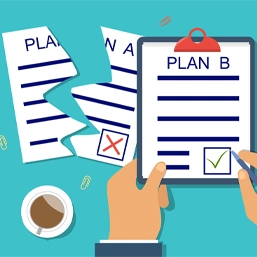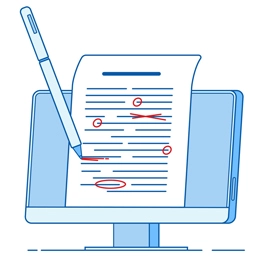
Bringing It To Life
The very best presentation is one that’s well thought out and anticipates any questions, answering them in advance.
– Nathan Collins
Introduction
Once you’ve outlined your speech and lined up some solid evidence to back up your ideas, it’s time to put all the pieces together. Whether you plan to write out your speech word for word or just speak from notes, you need to have a clear idea of what you want to say — the actual words, not just the ideas.
It is generally recommended not to have everything you want to say written down but rather a series of prompts. If you appear to be reading from a script, then there is less chance of you getting your point across with the power that you want it to have.
Nonetheless, you should refrain from improvising too much as there are clear disadvantages to this process, not least of them the fact that this is filled with risks such as momentarily being lost for words.
This makes you appear less competent, and people will be less likely to take you seriously. The general impression is that you should have in mind the body of what you want to say, and any additions, which occur to you, can always be included. Therefore, you do not have to worry about deviating from a pre-written speech, while also avoiding the dangers of having nothing to say.
Putting Together Your Presentation
Most of the time it’s a bad idea to read a presentation word for word. It’s boring and it makes it difficult to build a rapport with the audience. Any presentation is a kind of social occasion. If you just wanted people to hear what you have to say, you could print copies of your presentation and hand them out.

Effective speakers try to make a connection with their audience. Reading a speech word for word creates a barrier between the speaker and the audience and eliminates spontaneity. Your audience should feel like you’re having a conversation with them, not lecturing them.
If you are constantly referring to notes this makes it impossible to maintain any kind of eye contact with your audience, and you may as well record the speech and play it to them. Speaking from notes does not have the same problems connected with it – it simply allows you to have prompts from which to elaborate.
The main benefit to making a speech is that you allow your words to come alive. Speakers who have minimal notes and have thought long and hard about what they want to say and how they want to say it make some of the most impressive speeches. This allows them to maintain a rapport with their audience, and gives the words more resonance. Also, if you are reading from a full speech, this makes it more difficult to respond to questions, which may arise in the course of your presentation. Allowing your brain to do most of the work sharpens your reaction times and gives you greater credibility.
If you wish to write out any part of your speech or memorize it word for word, the best thing to do is write down what you will say in the first two or three minutes of the speech. From here you can usually gain the confidence that you require to give the rest of your speech more freely. By this point, you will have gained the confidence of your audience, who will be happy to hear what you have to say, and you will be “warmed up” – making the rest of the speech far more coherent and convincing.

Including a Backup Plan
It is almost inevitable that at some point you will encounter unexpected problems in giving presentations. How you handle these problems, will determine whether your presentation is a success or not.
Some people get very flustered when something goes wrong. They may become irritated or angry. The audience picks up on this emotion and starts to form a negative impression of the speaker. Skillful speakers treat unexpected problems humorously. If their projector doesn’t work or they trip over a cord, they make a joke out of it.
This puts everyone at ease and starts to build a rapport with the audience. This is one element, which separates comfortable public speakers from speakers who are less professional.
Everyone who has a Plan A recognizes the importance of having a Plan B (a backup plan). The thing that many people forget about plans is that they are not always going to be carried out in the conditions for which they were planned.
Things can go wrong without notice. Even if you have planned out every seemingly foreseeable eventuality there is always the danger that, for example, the power will go off in the middle of the presentation. How you react to these problems is almost as important as the quality of your speech.
Good public speakers will always be ready for the possibility of unforeseen problems. This does not mean that, should you spill something over your notes or have a momentary lapse of memory, you should launch into a stand-up comedy routine. It is much better to simply go into the speech you have planned with the awareness that you may need to “fill space”. One way in which people do this is to make light of the problem and – if you can think of a way to do so – make the unexpected problem into part of your Plan B or a backup plan.
For example – and this is a very specific example – if the power should cut out during a speech on the importance of energy efficiency, you can turn this into a jumping off point by saying “…and this is a good example of the importance of what I am talking about. Thank you very much for that illustration”. Of course, sometimes the fates will throw problems at you that are not so easily turned into a joke, but thinking on your feet will win you points.
Often, it is enough simply to know that you may encounter such problems and to have an attitude those things are in the lap of the gods. Having the confidence to turn them into something that can drive a presentation forward is the mark of a good speaker.
Reviewing, Editing, and Rewriting
Here are some things to look for in reviewing the first draft of a presentation:
Content and Organization:
- Does the opening provide a good idea of what the presentation is about?
- Are the main ideas arranged in a logical order?
- Are opinions backed up with facts, statistics, and authorities?

Language:
- Have you come with clear, effective statements of your main ideas?
- Have you eliminated jargon as much as possible?
- Have you used vocabulary that the audience will understand?
Length:
- Have you devoted an appropriate amount of time to each part of your presentation?
- Is your entire presentation an appropriate length?
Very few first drafts are good enough to be “the draft”. Unless you have immense clarity of thought and eerie foresight, the chances are that you will make a reference later on in your speech that either contradicts something you said before, or has a meaning that is not immediately clear to your listeners going on the basis of what you said before.
The first draft of a speech is about getting all your ideas on to the page and ensuring that they are coherently presented. The further drafts will be about ensuring that the speech flows like it should, and sounds like a complete document rather than a series of thoughts.
Writing a speech that takes all of the important factors into account first time is not impossible, but does take an inordinate period of time, and the final document can often sound like pages of research.
Getting the balance right between informative content and something that will hold the attention of your audience generally requires you to revisit the speech after you have written it. You could sit to write with a reference book in front of you, checking every fact, figure and quote before you commit it to paper. However, this approach almost always leads to a speech that has very little life in it.
The best bet is to write a draft of the speech that sounds like something you would say. The latter drafts of it will then take into account the details that you have checked, and any amendments you have made as a result of a read-through.
It may be that in the original draft you have given more time to one section than you have to another, equally important section. By adding and subtracting elements, you will have a speech that sounds coherent and impressive. By sitting and working on a first draft that takes everything into account and has all of the important facts and figures checked, you will have a speech that sounds like a research document.
Practical Application
Ronnie was about to leave for work, when he noticed that his co-worker, Lawanda’s light was still on in her office. He stopped by to check on her. “Working late tonight?”
Lawanda sighed, frustrated. “It’s just this speech I’m trying to start writing. I want everything to be perfect, but everything I write just sounds like…”
“… Your first draft?” Ronnie filled in.
Lawanda blinked and said, “What?”
Ronnie said, “Your first draft. The most important part of the first draft is getting all your ideas on to the page, not for everything to be perfect.”
Lawanda smiled. “Thanks, Ronnie. This speech isn’t due until next month. Maybe I should go back to this in the morning after a good night’s sleep.”
Lawanda worked on her speech the next day. It took her a few work days, but afterwards, she had a great first draft on her hands.





